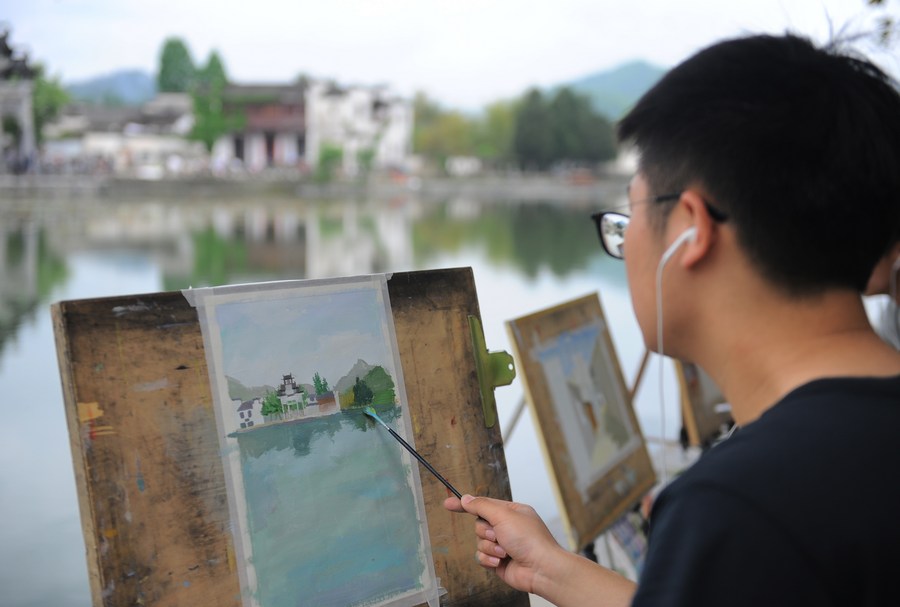China's rural tourism steps onto global stage, sees bright prospects
Two villages in east China were recently listed as some of the best examples of tourism villages in the world by the World Tourism Organization (UNWTO), along with 42 other villages out of 174 candidates from 32 countries.

Visitors work on paintings in Xidi scenic spot of Yixian County, east China's Anhui Province, April 24, 2019. (Xinhua/Ren Pengfei)
These two villages are Yucun in Zhejiang Province and Xidi in Anhui Province.
The two villages are pioneers in China's rural tourism sector. The honor they received this time marked a solid step taken by China's rural tourism toward the global stage.
According to a press conference held by the State Council Information Office this August, 3.09 billion visits were made to China's rural tourism destinations in 2019, accounting for half of the country's domestic tourist trips.
China's first agritainment facility was located in Sanyuan township, Pixian county, Chengdu, southwest China's Sichuan Province, and run by a local resident named Xu Jiyuan.
The facility was a historical type of residence built in 1986 that had structures on three sides of its courtyard. With flower beds placed in front of the houses and bonsai flowers surrounding it, the residence attracted many visitors.
As it turned into a famous attraction, some people urged Xu to open his yard to the public as a tourism destination, and that's how the first agritainment facility in China came into being.
As it entered the 21st century, China's rural tourism sector saw leapfrog development. Rural tourism was designated as the theme of the tourism sector across the country in 2006 by the National Tourism Administration (NTA), or what's known today as the Ministry of Culture and Tourism (MCT). In August of the same year, the NTA issued a guidance on the development of rural tourism, saying the sector has been developed in a lively, diversified and characteristic manner across the country, forcefully promoting the building of a new socialist countryside.
In 2007, the NTA and the Ministry of Agriculture, or what's known today as the Ministry of Agriculture and Rural Affairs, jointly issued a notice on boosting China's rural tourism, calling on the country to fully exploit the resources in agriculture, farmers and rural areas to drive the development of tourism.
The government work report of 2017 pointed out that rural tourism, leisure tourism and all-for-one tourism must be vigorously developed across the country, a macro policy that ushered in a brand new chapter of rural tourism.
Over the past 40 years, China's rural tourism has gradually become sustainable and green as a result of an extensive model of development, cultivating its own features at the same time.
For instance, Xidi, built in the Northern Song Dynasty (960-1127), is a village that sits in the mountains and has preserved its ancient structures well. Housing three ancestral halls, a memorial gate, and 224 residential buildings constructed in the Ming and Qing Dynasties (1368-1911), it is an outstanding representation of the ancient Hui style ancient village.
The village was listed as a UNESCO World Heritage Site in 2000. The UNWTO said the decision was made in recognition of the village's rich cultural and natural resources, as well as its efforts to pursue sustainable development.
Taking advantage of such cultural and natural resources, Xidi has gradually forged a healthy model of inheriting and developing its cultural heritage through tourism, and transitioned from an underdeveloped village into a world-famous tourism destination.
However, Yucun, located on the northern slope of the Tianmu Mountain, was just a plain village previously blighted by environmental issues due to quarrying business in the old days.
Guided by the vision of "lucid waters and lush mountains are invaluable assets," Yucun later got rid of the polluting business of quarrying and gradually made tourism its pillar industry. As a result, it has built itself into an extremely habitable village that offers great jobs for the locals and is attractive to outsiders.
The two villages succeeded through two completely different paths, which was a choice made by them according to their own conditions, as well as a manifestation of how green development philosophy is impacting China's rural tourism.
As an important part of the domestic tourism sector, rural tourism is playing an increasingly significant role in rural vitalization and the building of a beautiful countryside. All parts of China are currently exploring ways to better develop rural tourism and make the industry more sustainable.
According to a recent guidance issued by the Ministry of Agriculture and Rural Affairs, the number of tourism visits to rural destinations will reach 4 billion by 2025, and is expected to generate annual revenue of 1.2 trillion yuan ($189 billion).
Photos
Related Stories
- NW China county promotes rural tourism to help increase locals' incomes
- Villagers share courtyards to boost rural tourism in China's Ningxia
- Ecological protection efforts bolster rural tourism in NE China
- China embraces rural tourism boom amid COVID-19: U.S. media
- Rural tourism rebounds in China with more packages, services during Qingming holiday
Copyright © 2021 People's Daily Online. All Rights Reserved.










